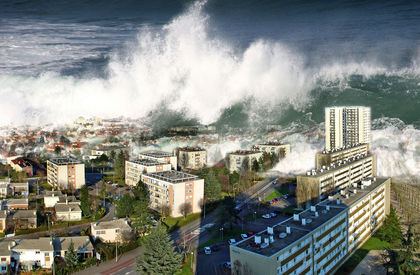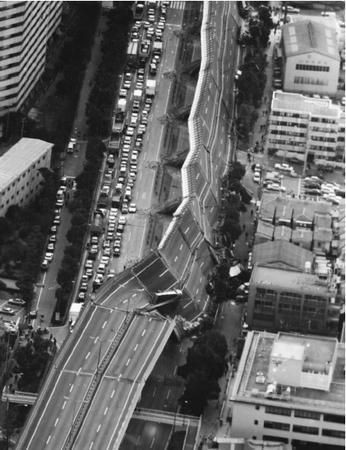Earthquake

An earthquake is an unpredictable event in which masses of rock shift below Earth's surface, releasing enormous amounts of energy and sending out shock waves that sometimes cause the ground to shake dramatically. Not all earthquakes are enormous, but they can become one of Earth's most destructive forces.
Causes of earthquakes
Earth's crust is composed of many huge, rocky plates known as tectonic plates. These plates constantly move slowly across the surface of Earth, bumping into each other, overrunning each other, and pulling away from each other. When the strain produced by these movements increases beyond a certain level, the pent-up energy ruptures the crust and creates a fracture known as a fault. The released pressure also causes the ground-shaking vibrations associated with an earthquake.
The motion of earthquakes: Seismic waves
The vibrations transmitting the shock of an earthquake are called seismic waves (pronounced SIZE-mik). These waves travel outward in all directions, like ripples from a stone dropped in a pond. The area where energy is first released to cause an earthquake is called the focus. The focus lies underground at a shallow, intermediate, or deep depth—down to about 430 miles (700 kilometers). The epicenter is the point on Earth's surface directly above the focus.
Seismic waves travel both through Earth and along its surface. Waves traveling through Earth are called body waves. The two main types are P waves (primary) and S waves (secondary). P waves stretch and compress the rock in their path through Earth. The fastest waves, they move at about 4 miles (6.4 kilometers) per second. S waves move the rock in their path up and down and side to side. They move at about 2 miles (3.2 kilometers) per second.
Words to Know
Epicenter: The location where the seismic waves of an earthquake first appear on the surface, usually almost directly above the focus.
Fault: A crack running through rock that is the result of tectonic forces.
Focus: The underground location of the seismic event that causes an earthquake.
Modified Mercalli scale: A scale used to compare earthquakes based on the effects they cause.
Richter scale: A scale used to compare earthquakes based on the energy released by the earthquake.
Seismic waves: Classified as body waves or surface waves, vibrations in rock and soil that transfer the force of the earthquake from the focus into the surrounding area.
Seismic waves traveling along Earth's surface are called surface waves or L waves (long). The two main types, Rayleigh waves and Love waves, are named after two prominent seismologists (scientists who study earthquakes). Although surface waves move slower than body waves—less than 2 miles (3.2 kilometers) per second—they cause greater damage. Rayleigh waves cause the ground surface in their path to ripple with little waves. Love waves move in a zigzag along the ground. Both Rayleigh and Love waves set off avalanches, landslides, and other earthquake damage.
Measuring earthquakes
An earthquake's power can be measured in two ways: by intensity (strength) and magnitude (ground covered). While intensity of an earthquake is usually described through people's perceptions and the amount of property destroyed, magnitude is measured by using seismographs or devices that detect ground movement.
Intensity can be measured using the modified Mercalli scale. First developed by Italian seismologist Guiseppe Mercalli (1850–1914) in 1902, the scale compares the surface effects of earthquakes to each other. It is divided into 12 levels, from level 1 meaning "felt by few" to level 12 meaning "total damage."
Tsunami
A tsunami is a giant wave created by an underwater earthquake, volcano, or landslide. As part of the seabed (ocean floor) rises or drops, water is displaced or moved, producing a great wave. A tsunami (Japanese for "harbor wave") crosses the deep ocean at speeds up to 500 miles (800 kilometers) per hour, but it is only detectable on the surface as a low swell (a wave with no crest). As the giant wave approaches the shallows near shore, it slows down and rises up dramatically, often as much as 200 feet (60 meters). It then strikes the shore with unstoppable force. A wall of water forms when a large tsunami enters straight into a shallow bay or estuary, and can move upriver for many miles.
Magnitude is measured using the Richter scale, developed by American seismologist Charles F. Richter (1900–1985) in 1935. The Richter scale compares the energy released by an earthquake to the energy released by other earthquakes. Each whole number increase in value on the

scale indicates a 10-fold increase in the energy released and a 30-fold increase in ground motion. Therefore, an earthquake of 6 on the Richter scale is 10 times more powerful than an earthquake with a value of 5, which is 10 times more powerful than an earthquake with a value of 4. An earthquake that measures 8 or above on the Richter scale causes total damage.
Earthquake occurrence and prediction
Earth experiences more than one million earthquakes a year. The vast majority of these measure 3.4 or below on the Richter scale and cannot be felt by people. The planet never ceases to vibrate with the motion of its tectonic forces. Full of heat and kinetic energy (the energy of an object due to its motion), Earth has been resounding with the violence of earthquakes for more than four billion years. In recorded human history, great earthquakes have been responsible for some of the most horrendous natural disasters. In the past 800 years, 17 earthquakes have each caused 50,000 or more deaths.
At the beginning of the twenty-first century, an estimated 100 million Americans live on or near an active earthquake fault. Hundreds of millions more lived on or near such faults around the world. Knowing

the exact time and place an earthquake will occur still lies beyond the ability of scientists. However, in order to interpret seismic activity and possibly to prevent needless deaths, seismologists constantly monitor the stresses within Earth's crust. Ultrasensitive instruments placed across faults at the surface measure the slow, almost imperceptible movement of plates. Other instruments measure phenomena that seem to precede earthquakes. These include changes in tide and ground-water levels, fluctuations in the magnetic properties of rocks, and the swelling or tilting of the ground. Peculiar animal behavior has also been reported before many earthquakes, and scientific research into this phenomenon has been conducted.
[ See also Fault ; Plate tectonics ]
thanx
look at more pictures of your earthquakes and write a summary about it.
I would also faint if you were to go crazy screaming an earthquake is coming an earthquake is coming.Stay calm and you will be fine.You would have to stay home for a few days or weeks because of the big crack in the middle of the streets or in the middle of the building.No one knows when a earthquake is going to happen.You would be a genius if you were to know when a earthquake is going to happen.If you were to scream an earthquake is coming and it really came you would have a good mind.
Thanks
Kwadwo